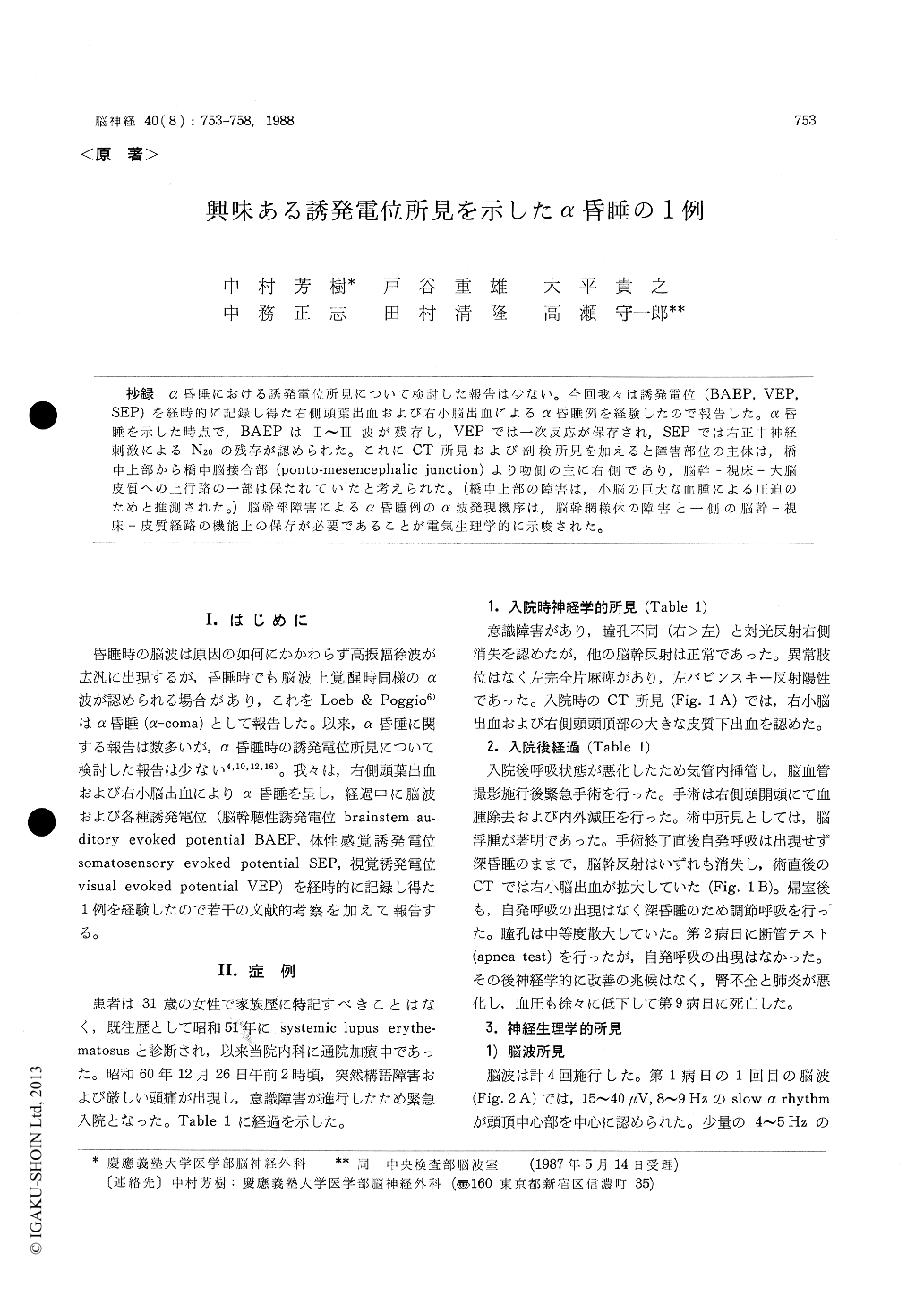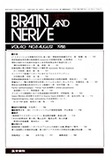Japanese
English
- 有料閲覧
- Abstract 文献概要
- 1ページ目 Look Inside
抄録 α昏睡における誘発電位所見について検討した報告は少ない。今回我々は誘発電位(BAEP, VEP,SEP)を経時的に記録し得た右側頭葉出血および右小脳出血によるα昏睡例を経験したので報告した。α昏睡を示した時点で,BAEPはI〜III波が残存し,VEPでは一次反応が保存され,SEPでは右正中神経刺激によるN20の残存が認められた。これにCT所見および剖検所見を加えると障害部位の主体は,橋中上部から橋中脳接合部(ponto-mesencephalic junction)より吻側の主に右側であり,脳幹—視床—大脳皮質への上行路の一部は保たれていたと考えられた。(橋中上部の障害は,小脳の巨大な血腫による圧迫のためと推測された。)脳幹部障害によるα昏睡例のα波発現機序は,脳幹網様体の障害と一側の脳幹—視床—皮質経路の機能上の保存が必要であることが電気生理学的に示唆された。
A 31-year-old woman was admitted because of severe headache and dysarthria in December 1985. Neurological examination on admission revealed severe impairment of consciousness, anisocoria, absent light reflex on the right side, and evi-dence of left hemiparesis, but other brainstem reflexes were intact. A CT scan taken shortly after arrival demonstrated a large hematoma in the right temporal lobe and the right cerebellum. Breathing became irregular and intubation was needed. An emergency operation was performed. After the operation the patient remained comatose without any spontaneous respiration or brainstem reflexes.
The next day she was still comatose without any spontaneous movement and other neurological finding remained unchanged. An initial EEG obtained at this time showed an 8- to 9-Hz alpha rhythm of about 15~40 μV with preponderance over the posterior and central regions. Some spontaneous variability was noted.
The same day, investigations of brainstem au-ditory evoked potential (BAEP), visual evoked po-tential (VEP), and somatosensory evoked potential (SEP) were performed. BAEP showed only the first, second and third waves (I~III) bilaterally. VEP was able to elicit the primary response (II~III) without the secondary response. SEP could not be obtained from the early cortical response to left median nerve stimulation, but showed N14 bilaterally and small N20 upon right median nerve stimulation.
On the second day of hospitalization, a repeated EEG showed generalized slowing with loss ofalpha frequency rhythms and it proved impossible for SEP to elicit N20 bilaterally. At this time, BAEP showed bilateral I~IIIth waves and VEP still showed primary response. The EEG and evoked potentials eight days after onset revealed no activity and no response. She developed pul-monary infection and died from cardiac arrhyth-mia on the tenth hospital day.
At autopsy, a large hematoma was present inthe right temporal lobe extending to the occipital lobe, and also in the right cerebellar hemisphere with involvement of the midbrain.
These electrophysiological and pathological find-ings suggest that alpha coma due to brainstem dysfunction occurs due to damage of the brainstem reticular formation with sufficient sparing of the diencelphalic and cortical neurones.

Copyright © 1988, Igaku-Shoin Ltd. All rights reserved.


